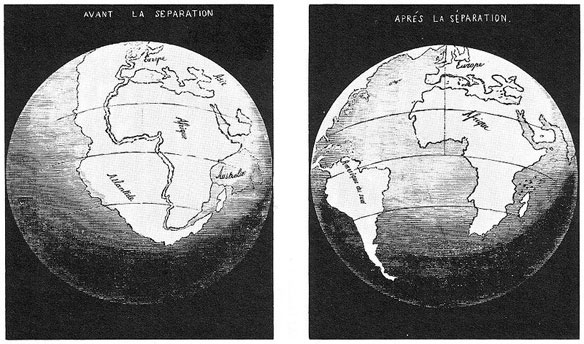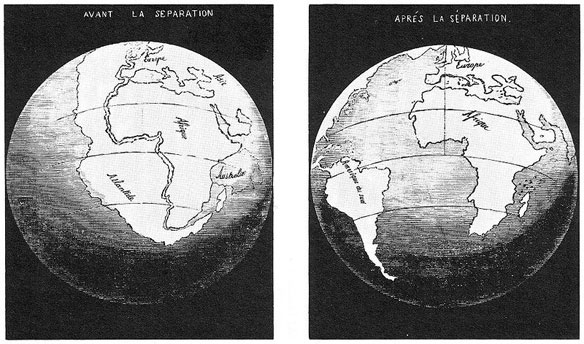
First known illustration of the Opening of the Atlantic Ocean, by Antonio Snider-Pellegrini, 1858. Photo source: Public Domain / Wikipedia.
By Bill Steigerwald, NASA / Goddard Space Flight Center
A layer of partially molten rock about 22 to 75 miles underground can’t be the only mechanism that allows continents to gradually shift their position over millions of years, according to a NASA-sponsored researcher. The result gives insight into what allows plate tectonics, the movement of the Earth’s crustal plates, to occur.
“This melt-rich layer is actually quite spotty under the Pacific Ocean basin and surrounding areas, as revealed by my analysis of seismometer data,” says Dr. Nicholas Schmerr, a NASA Postdoctoral Program fellow. “Since it only exists in certain places, it can’t be the only reason why rigid crustal plates carrying the continents can slide over softer rock below.” Schmerr, who is stationed at NASA’s Goddard Space Flight Center in Greenbelt, Md., is author of a paper on this research appearing in Science March 23.
The slow slide of Earth’s continents results from plate tectonics. Our planet is more than four billion years old, and over this time, the forces of plate tectonics have carried continents many thousands of miles, forging mountain ranges when they collided and valleys that sometimes filled with oceans when they were torn apart. This continental drift could also have changed the climate by redirecting currents in the ocean and atmosphere.
The outermost layer of Earth, the lithosphere, is broken into numerous tectonic plates. The lithosphere consists of the crust and an underlying layer of cool and rigid mantle. Beneath the oceans, the lithosphere is relatively thin (about 65 miles), though beneath continents, it can be as thick as 200 miles. Lying beneath the lithosphere is the asthenosphere, a layer of rock that is slowly deforming and gradually flowing like taffy. Heat in Earth’s core produced by the radioactive decay of elements escapes and warms mantle rocks above, making them softer and less viscous, and also causes them to convect. Like the circulating blobs in a lava lamp, rock in the mantle rises where it is warmer than its surroundings, and sinks where it’s cooler. This churn moves the continental plates above, similar to the way a raft of froth gets pushed around the surface of a simmering pot of soup.
Although the basic process that drives plate tectonics is understood, many details remain a mystery. “Something has to decouple the crustal plates from the asthenosphere so they can slide over it,” says Schmerr. “Numerous theories have been proposed, and one of those was that a melt-rich layer lubricates the boundary between the lithosphere and the asthenosphere, allowing the crustal plates to slide. However, since this layer is only present in certain regions under the Pacific plate, it can’t be the only mechanism that allows plate tectonics to happen there. Something else must be letting the plate slide in areas where the melt doesn’t exist.”
Other possible mechanisms that would make the boundary between the lithosphere and the asthenosphere flow more easily include the addition of volatile material like water to the rock and differences in composition, temperature, or the grain size of minerals in this region. However, current data lacks the resolution to distinguish among them.

This diagram represents a cross-section of the Earth beneath the ocean, with the layers labeled on the right. It illustrates the paths of earthquake waves (white lines) from an earthquake source (white star) through the Earth to a seismometer location (blue triangle). Halfway through their journey, the waves can reflect off of the surface or a melt layer. The longer path goes all the way to the surface before the waves are reflected. A shorter path is possible if the waves get reflected off of a melt layer at the lithosphere-asthenosphere boundary (represented by the yellow-orange area beneath the hotspot). Waves taking this shorter path will arrive several tens of seconds before waves that miss the melt layer and have to travel to the surface. Image and captions: Nicholas Schmerr.
Schmerr made the discovery by analyzing the arrival times of earthquake waves at seismometers around the globe. Earthquakes generate various kinds of waves; one type has a back-and-forth motion and is called a shear wave, or S-wave. S-waves traveling through the Earth will bounce or reflect off material interfaces inside the Earth, arriving at different times depending on where they interact with these interfaces.
One type of S-wave reflects from Earth’s surface halfway between an earthquake and a seismometer. An S-wave encountering a deeper melt layer at the lithosphere-asthenosphere boundary at this location will take a slightly shorter path to the seismometer and therefore arrive several tens of seconds earlier. By comparing the arrival times, heights, and shapes of the primary and the melt-layer-reflected waves at various locations, Schmerr could estimate the depth and seismic properties of melt layers under the Pacific Ocean basin.
“Most of the melt layers are where you would expect to find them, like under volcanic regions like Hawaii and various active undersea volcanoes, or around subduction zones – areas at the edge of a continental plate where the oceanic plate is sinking into the deep interior and producing melt,” said Schmerr. “However, the interesting result is that this layer does not exist everywhere, suggesting something other than melt is needed to explain the properties of the asthenosphere.”
Understanding how plate tectonics works on Earth could help us figure out how other rocky planets evolved, according to Schmerr. For example, Venus has no oceans, and no evidence of plate tectonics, either. This might be a clue that water is needed for plate tectonics to work. One theory proposes that without water, the asthenosphere of Venus will be more rigid and unable to sustain plates, suggesting internal heat is released in some other way, maybe through periodic eruptions of global volcanism.
Flipped from Head to Toe: 100 Years of Continental Drift Theory









